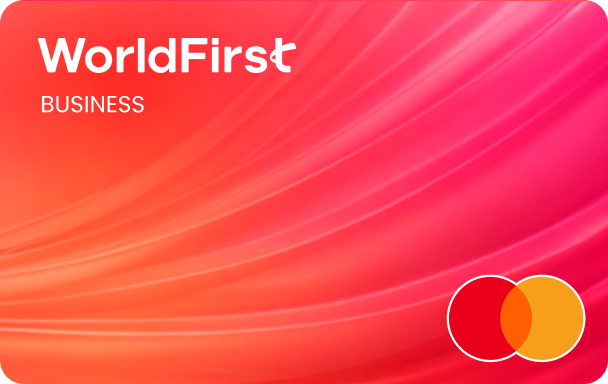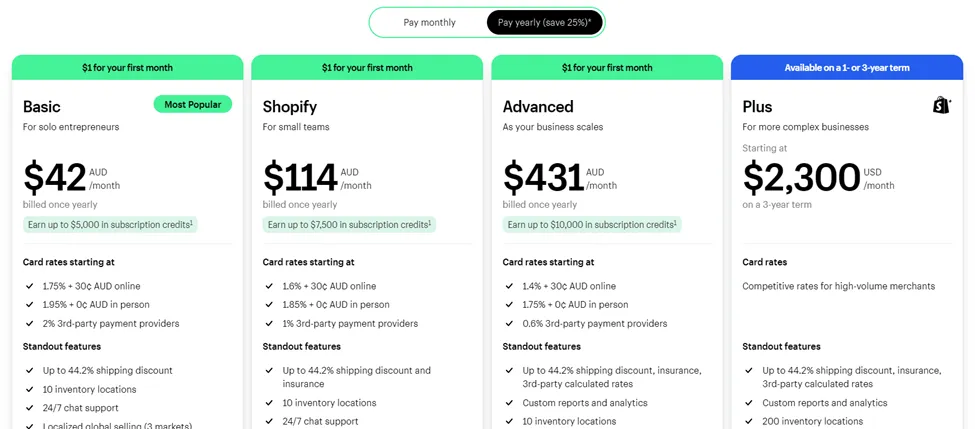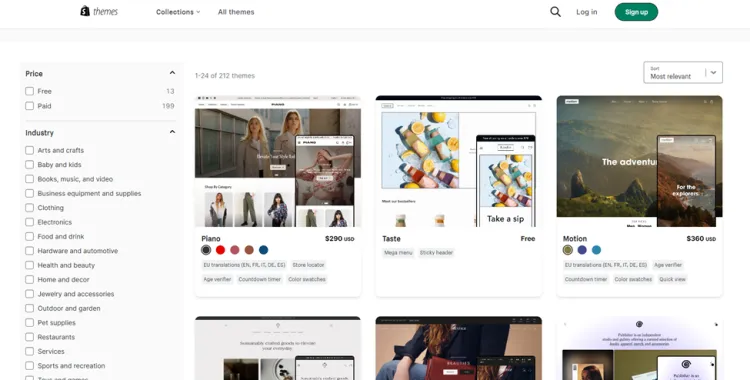How to set up a Shopify store: The complete beginner’s guide
Last updated: 27.09.2024
We breakdown the process of setting up a Shopify store and collecting payments in multiple currencies
Key takeaways
- Shopify is an e-commerce platform that allows businesses to set up their own online store
- You can either set up a new website domain or redirect your Shopify store to an existing domain
- Use automated or manual collections to organise products.
- Selling and getting paid in multiple currencies is possible
- A World Account lets you accept payments from Shopify in 15+ currencies

Introduction
Shopify is a beginner-friendly e-commerce platform that allows you to build and manage your online store without coding. With over 4 million active websites running on Shopify, it is one of the most popular e-commerce platforms globally.
Shopify claims 10% of the worldwide e-commerce software market share. Major brands like Decathlon, Netflix, and Fashion Nova use the platform. In Australia alone, there are over 150,000 live Shopify stores.
You can easily scale your Shopify store as your business grows in size–add more product categories, expand to more countries, and even accept payments in multiple currencies.
Want to learn more about how to create a Shopify store? This step-by-step Shopify guide walks you through the entire process.
Table of Contents
What is Shopify?
Shopify is a cloud-based e-commerce platform that allows businesses to set up their own online stores without coding. It is basically a website builder for online stores. You can add custom functionalities to your Shopify website through its built-in features or third-party apps.
You can also integrate other marketplaces, such as AliExpress and Alibaba, to automatically migrate product data and quickly set up the online store.
How much does it cost to set up a Shopify store?
Shopify offers four different pricing plans for businesses in Australia, starting at AUD 56 per month. The main difference between the plans is the number of features.
If you choose to be billed annually, you get a 25% discount on these prices. A 14-day trial period is also available.
Source: Shopify
How to set up Shopify store in 7 steps
Let’s take a look at the steps for building a website on Shopify:
1. Sign up for Shopify
Go to Shopify and set up a new account. You can start with a free trial or directly set up a paid Shopify account.
a. Enter your email address and create a password
b. Choose a Shopify plan that fits your current business needs (You can always scale up or down)
c. Decide on a store name that will become your domain. The default domain name will be in the format storename.shopify.com (You can redirect this to your custom domain later)
d. Provide more details about your business like the legal registered business name and address, store time zone, default currency, and default weight unit
e. Add your order ID format
2. Set up a domain for your store
As mentioned above, your initial store name will be set up as a Shopify subdomain with the format storename.shopify.com.
There are two ways to get your custom domain:
- Purchase a domain directly through Shopify
- Purchase a new domain from a third-party provider and link it to your Shopify store
- Use an existing domain
Once you have your domain, you can redirect your Shopify store to it.
3. Pick a theme for your store
Next, you need to choose a theme for your Shopify site. You can use one of the eight free themes or purchase a paid theme.
Source: Shopify
Here are the steps to add a free theme to your Shopify store:
a. Go to Shopify Admin > Online Store > Themes
b. In the Free Themes section, click on Explore Free Themes
c. A new window will open listing all the available free themes
d. To apply a new theme, click on the ‘Add’ button
Here are the steps to add a paid theme to your Shopify store
a. Go to the Shopify Theme Store and select a theme you like
b. Click on ‘Try theme’ to get a preview of how the theme will look on your online store.
c. You can also customise the theme according to your requirements
d. If you like the theme and want to use it for your store, click on Buy theme and approve the payment. Once the payment is cleared, the theme will appear in your admin dashboard along with the other paid themes
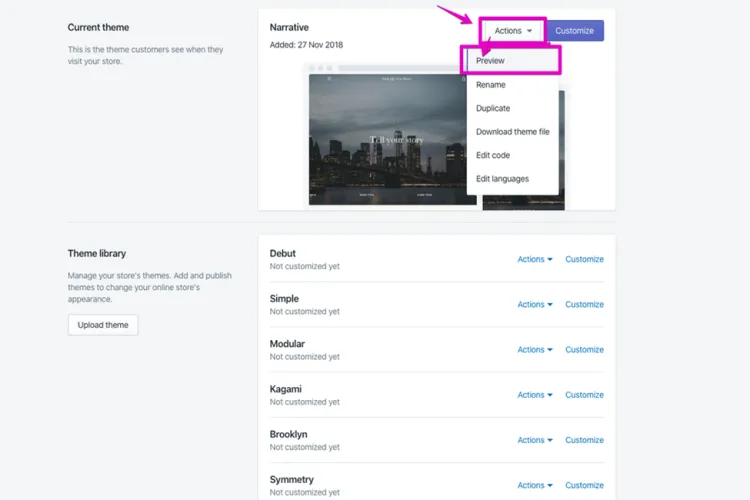
Source: Shopify
(Note: All of the Shopify paid themes are non-refundable. So, make sure they fit your needs before you make a purchase.)
4. Add a product
Product pages are the heart of any e-commerce website. Your product pages don’t need to look great. They should just be compelling enough to turn new visitors into paying customers.
Here are the steps to add products on Shopify:
a. Go to Shopify Admin > Products
b. Click on Add products
c. Add product title along with other details like:
- Category
- Inventory
- Item specifications
- Images
- Pricing
- Shipping
- Variants
- FAQs
To add custom fields apart from the default ones mentioned above, you can use the metafields feature.
d. Click on publish or keep the product page in drafts until it’s time to take them live
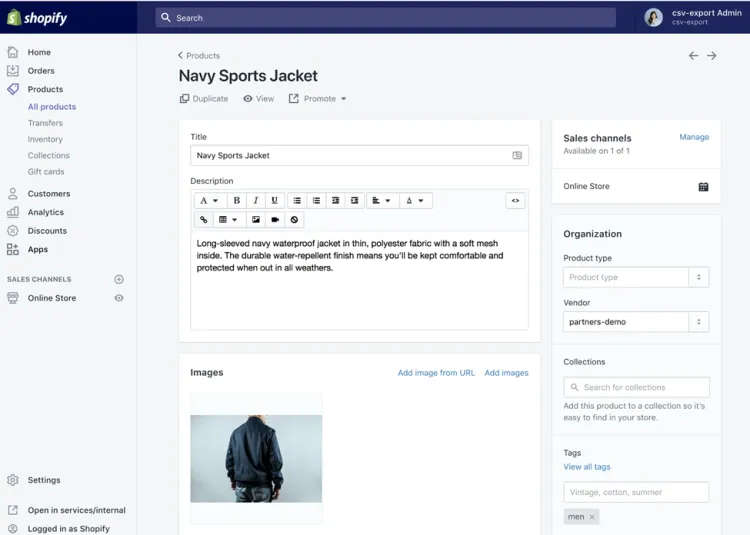
Source: Shopify
You can set three different statuses for product pages: Active, Draft and Archive.
The product status of new products is Active by default and they go online as soon as you hit publish. Product pages created by duplicating other pages are set to Draft by default.
- Open 15+ local currency accounts and get paid like a local
- Pay suppliers, partners and staff worldwide in 100+ currencies
- Collect payments for free from 130+ marketplaces and payment gateways, including Amazon, Etsy, PayPal and Shopify
- Take control of spending with the World Card, a business expense card that saves you more with 1% cashback. Learn more
- Save with competitive exchange rates on currency conversions and transfers
- Lock in exchange rates for up to 24 months for cash flow certainty
5. Organise your products
Product organisation on a Shopify online store is pivotal for search engine optimization and customer experience. When your website is difficult to navigate and customers cannot find the products they are looking for, they are bound to get frustrated and go somewhere else instead.
A well-organised website that focuses on customer experience significantly improves conversions.
You can use ‘collections’ on Shopify to organise products. Collection is just another word that Shopify uses for categories.
Some examples of collections include:
- Clothing for men, women, or kids
- Products available for sale
- Products in a certain colour or size
There are two types of collections you can create on your Shopify website: Manual and automated.
With manual collections, you have to manually add each product to a collection.
With automated collections, you set specific collection conditions and all the products that match these conditions are automatically added to the collection.
How to create a manual collection on Shopify?
a. Go to Shopify Admin > Products > Collections
b. Click on ‘Create collection’
c. Add the title and description of the collection. In the collection type, select Manual. Click on Save
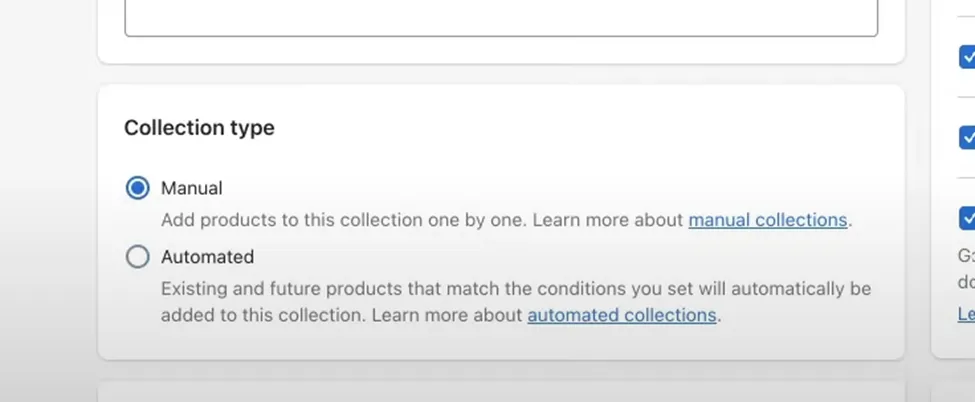
Source: Shopify
d. Go to the Products section and search/ browse products to add them to the new collection. Alternatively, you can also go to Shopify admin > Products > Select the product you want to add to the collection > Go to the collection section > Select one or more existing collections and click on save to directly add the product(s) to multiple collections
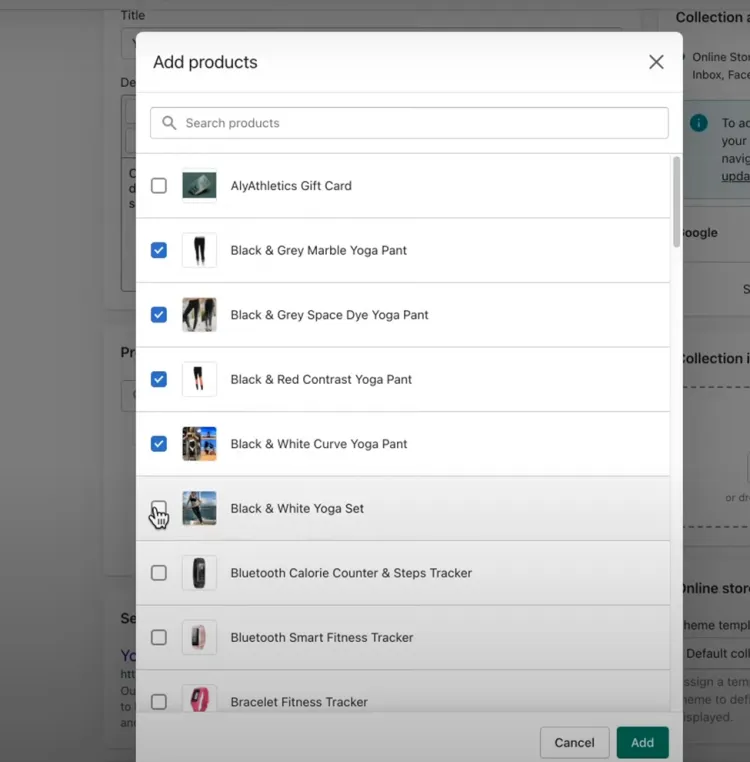
Source: Shopify
e. Optional: Change the sort order for the products added to the collection
f. Click on Save
g. Add the collection link in your store navigation or any other location
How to create an automated collection on Shopify
a. Go to Shopify Admin > Products > Collections
b. Click on ‘Create collection’
c. Add the title and description of the collection. In the collection type, select Automated. Click on Save
d. Use the drop-down list to set the main collection conditions
e. Select whether the products need to match all the conditions or just any of the conditions you have set
f. Click on Save
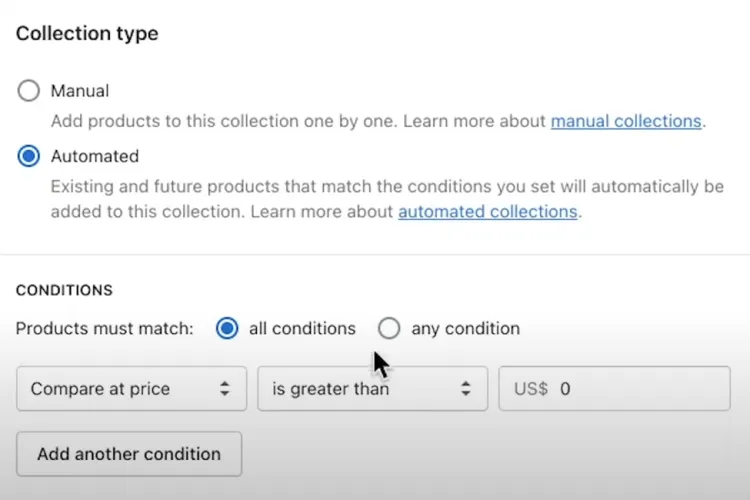
Source: Shopify
The products that match the conditions will be automatically added to the collection.
6. Set shipping
When you have set up a shipping strategy for your online store, you can incorporate it into your Shopify store. You can either add a flat rate or calculate shipping rates for products.
Shopify gives you the option to set different shipping rates for different products by using shipping profiles.
General shipping profile: This is the default shipping profile. If all the products in your store will have the same shipping rates, you can use a general shipping profile.
Custom shipping profile: If you have different shipping rates for different products, you can create a custom shipping profile for each category. Shopify allows you to set up to 99 custom shipping profiles.
Here are some examples of how you can use custom shipping profiles on Shopify:
- If you sell some heavy-weight products as part of your catalogue, you can create a separate shipping profile and charge a different shipping rate for these products
- If you ship to multiple locations, you can set shipping rates for each through custom profiles
Here are the steps to add shipping rates and conditions to your Shopify store:
a. Go to Shopify Admin dashboard > Settings > Shipping and delivery
b. Go to the shipping zone you want to add the rate to and click on ‘Add rate.’ (Shipping zones in Shopify are regions or groups of countries)
c. Select the transit time and enter the shipping rate
d. Select the local currency for the region or country so your customers can view the shipping rates in their local currency
e. Optional: Add any weight-based or price-based conditions
f. Click Done
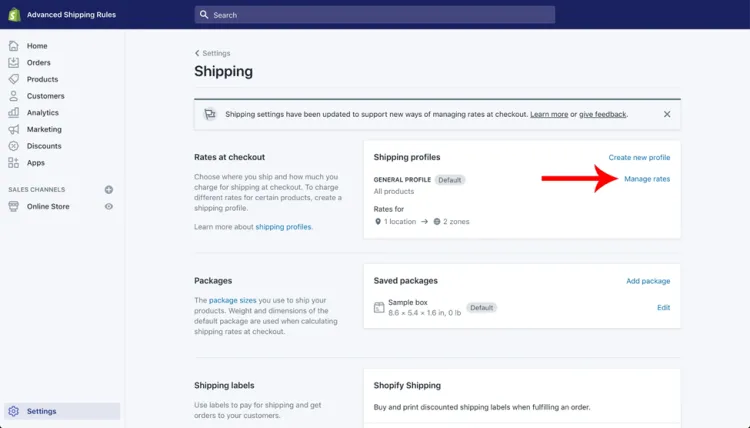
Source: Shopify
7. Setup payments and taxes
You can accept payments on Shopify through Shopify Payments, the default payment gateway, or through other third-party payment gateways such as Stripe.
The exact list of supported payment gateways will depend on your location and your customers’ locations. Review the list to check which payment gateways are available in your region and what currencies they support.
How to sell and get paid in multiple currencies on Shopify?
With Shopify, selling and getting paid in multiple currencies is possible.
The currency that your customers use to pay on your Shopify online store can differ from the currency of your payouts. In other words, your store currency can be different from the currency of your bank account.
Shopify can automatically detect the location of your customers and convert the product prices into their local currency.
Sellers can also add different bank accounts for different currencies. However, you can only add one bank account for each currency.
When you receive payouts in currencies that don’t have a linked bank account, the total amount is converted to the currency of your default bank account. A market currency conversion rate and a 1.5% conversion fee are usually charged for the transaction.
To save on transaction fees and protect your profit margins, you can open local accounts in multiple currencies and link them to your Shopify account.
You can set up a World Account to accept payments from Shopify in 15+ currencies, including GBP, USD, EUR, CAD, JPY, AUD, SGD, NZD, HKD and CNH.
With a World Account, you can
- Collect payments from 100+ global marketplaces and payment gateways, including Amazon, eBay, Etsy, AliExpress, and Stripe
- Hold your earnings in the original currency to fund supplier payments or withdraw them to your bank account at competitive exchange rates
- Send and receive payments in 40+ currencies across 130+ countries and regions
Build your first Shopify store
Learning how to use Shopify can be overwhelming at first, so take things one at a time.
Setting up your Shopify webstore is the first step towards building a successful online selling business. The main challenge lies in marketing your products and providing a great customer experience.
Disclaimer: The information contained is general only and largely our views. Before acting on the information you should consider whether it is appropriate for you, in light of your objectives, financial situation or needs. Although information has been obtained from and is based upon multiple sources the author believes to be reliable, we do not guarantee its accuracy and it may be incomplete or condensed. All opinions, estimates, mentioned products/services and referenced material constitute the author’s own judgement as of the date of the briefing and are subject to change without notice. WorldFirst shall not be responsible for any losses or damages arising from your reliance of such information.


Guide to selling on Etsy Australia
Etsy is an online marketplace where business owners, artists, and individuals can sell their products.
Apr / 2025
Amazon FBA Australia: Guide for new sellers
Amazon has been offering FBA services to Australian sellers since 2017. Take a look at our complete guide to Amazon FBA Australia
Apr / 2025
How to sell on Temu Australia
Learn how to sell on Temu Australia, from setting up a store to boosting sales. Discover key categories, fees, fulfillment options and tips for success.
Apr / 2025Choose a category below for more business, finance and foreign exchange support from WorldFirst.
- Almost 1,000,000 businesses have sent USD$300B around the world with WorldFirst and its partner brands since 2004
- Your money is safeguarded with leading financial institutions





